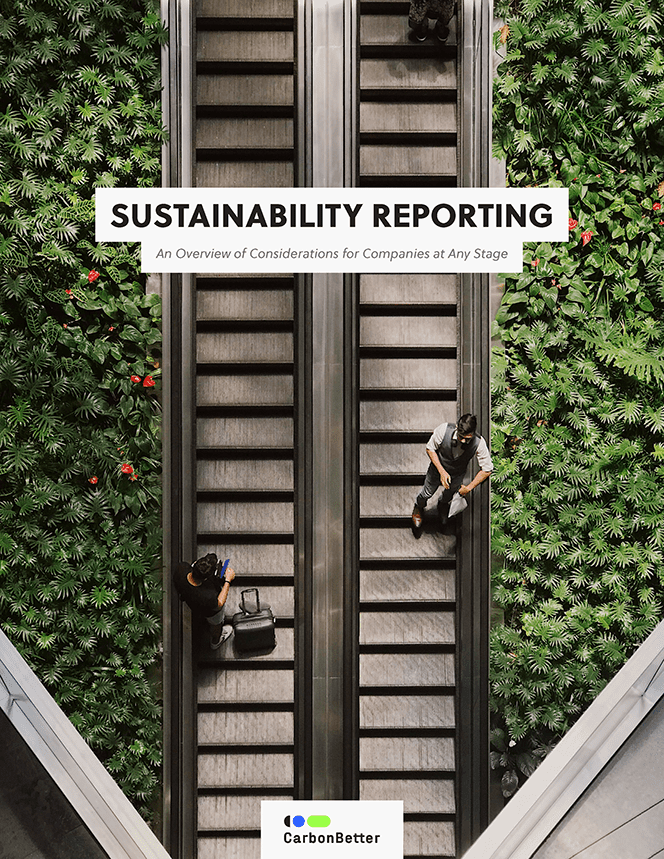Decarbonizing the Financial Services Industry to Support the Climate Transition

The link between climate risk & banking risk and the important role financial institutions serve in reducing global GHG emissions.
Currently, the world is not on track to reach the Paris Agreement goal to limit global warming to no more than 1.5°C above pre-industrial levels, with predictions that warming will reach 2.8°C by the end of the century. To reach the Paris Agreement goal, carbon neutrality needs to be achieved by 2050, which comes with an estimated annual global cost of $3.5 trillion. By acting as a source of financing and risk management, financial institutions play a key role in enabling and accelerating the transition to a more climate-friendly world.
Banks around the world are already beginning to recognize the importance of this issue as demonstrated by the formation of groups, such as the Glasgow Financial Alliance for Net Zero (GFANZ) and the Net-Zero Banking Alliance (NZBA), who provide resources and support for banks to set and achieve decarbonization goals. As the financial sector continues to increase its focus on sustainability, it is important for all financial institutions to understand what climate risks they may face, how their operations contribute to greenhouse gas (GHG) emissions, and the actions they can take to decarbonize.
Climate Risk
Climate change can pose various risks to the financial sector, including both physical and transition climate risks. Physical risks are those directly related to the impacts of climate change, such as extreme weather events, shifting weather patterns, and rising sea levels. Transition risks encompass those related to the changes required to shift to a more sustainable world, including expanding regulations, stakeholder pressures, and market shifts. To better understand how climate risks impact the financial sector, they can be mapped to traditional banking risks, as shown in Figure 1 below.
Figure 1. Linking Climate Risks with Banking Risks
| Banking Risk Type | Climate Risk Type | Description |
| Credit Risk | Physical Risk | The increased frequency and severity of extreme weather events associated with climate change can increase default rates and lower collateral values, especially for borrowers in industries that are heavily dependent on predictable environmental conditions, such as agriculture. |
| Operational Risk | Physical Risk | Operational delays and downtime associated with severe weather events can occur if there is damage to power sources, office buildings, or areas near employees. New processes and technologies may need to be adopted to minimize operational interruptions in these events. |
| Transition Risk | As part of their Scope 3 emissions, some companies are beginning to assess their “financial supply chain” which can consist of banks, retirement funds, and credit card providers. Lack of preparedness to respond to data requests or insufficient actions to address high emissions can cause clients to switch to different lenders. | |
| Transition Risk | Internally, sufficient governance changes and employee training may be needed to adequately incorporate climate risk into business operations. | |
| Transition Risk | Operational costs can also increase due to rising costs of fuel, water, and energy. | |
| Market Risk | Physical Risk | Climate change can increase stranded assets and the associated negative consequences. Some examples include coastal properties losing value more rapidly than expected due to rising sea levels, or assets being damaged during severe weather events and lowering their value. |
| Transition Risk | Some industries, such as fossil fuels, will face decreased market demand and increased stranded assets as a result of the transition to cleaner energy. Other sectors can also be impacted by rising input prices, as the costs for water, energy, and agricultural products are expected to rise due to climate conditions. | |
| Liquidity Risk | Physical Risk | Lenders can feel stress on their liquidity following climate change related natural disasters, where many borrowers that operate in the same geographic region would need to draw down deposits and credit lines to finance recovery. |
| Reputation Risk | Transition Risk | As climate change continues to become an increasingly important issue to stakeholders, financial institutions need to account for how their actions impact their reputation and social license to operate. In addition to actions taken, climate claims and commitments need to have clear metrics and transparent progress reporting in order to maintain trust. |
| Policy & Legal Risk | Transition Risk | Financial institutions need to ensure they have sufficient measurement and reporting capabilities in order to stay in compliance with the expanding regulatory landscape (e.g. CSRD, ISSB, and SEC proposed climate disclosure rule). |
| Transition Risk | Various policy-based carbon pricing mechanisms (e.g. ETS, carbon tax) can impact the value of portfolio companies. For example, if carbon prices or penalties for emissions increase, carbon-intensive sectors may lose value. |
In order to better inform climate risk mitigation strategies, financial institutions should conduct climate risk assessments and scenario analyses. The Task Force on Climate-Related Financial Disclosures (TCFD) provides guidance and resources for effectively evaluating climate-related risks.
Measuring Emissions
To have a better understanding of how their operations are contributing to the climate crisis, banks should be calculating their Scope 1, 2, and 3 GHG emissions. Having an accurate baseline is an important first step to working towards achieving net-zero. Scope 1 emissions are direct emissions, such as fuel consumption in company owned buildings and vehicles. Scope 2 encompasses indirect emissions through purchasing energy. Scope 3 covers 15 categories of indirect value chain emissions, including capital goods, business travel, and waste generated in operations.
For financial institutions, the most significant source of emissions are from Scope 3 Category 15 (Investments). These financed emissions can represent over 95% of a bank’s overall GHG footprint and can be very complex to calculate, as they can encompass multiple sectors and asset classes. One major hurdle is data quality—the diversity and scale of portfolios can lead to inconsistent emissions data, or missing data in some cases. In addition to challenges with acquiring data, there may also be technological barriers for processing and computation. Because of this, it’s important for financial institutions to start early on ensuring the necessary processes and capabilities are in place for carbon accounting. The GHG protocol provides guidance on what should be included in calculations and the associated methodologies, as shown in Figure 2.1 and Figure 2.2 below.
Figure 2.1 GHG protocol guidance for Scope 3 Category 15 (Required)
| Financial Investment / Service | Description | GHG Accounting Approach (Required) |
| Equity investments | Equity investments made by the reporting company using the company's own capital and balance sheet, including:
| In general, companies in the financial services sector should account for emissions from equity investments in scope 1 and scope 2 by using the equity share consolidation approach to obtain representative scope 1 and scope 2 inventories. If emissions from equity investments are not included in scope 1 or scope 2 (because the reporting company uses either the operational control or financial control consolidation approach and does not have control over the investee), account for proportional Scope 1 and Scope 2 emissions of equity investments that occur in the reporting year in scope 3, category 15 (Investments). |
| If not included in the reporting company's scope 1 and scope 2 inventories: Account for proportional Scope 1 and Scope 2 emissions of equity investments that occur in the reporting year in scope 3, category 15 (Investments). Companies may establish a materiality threshold (e.g., equity share of 1 percent) below which the company excludes equity investments from the inventory, if disclosed and justified. | |
| Debt investments (with known use of proceeds) | Corporate debt holdings held in the reporting company's portfolio, including corporate debt instruments (such as bonds or convertible bonds prior to conversion) or commercial loans, with known use of proceeds (i.e., where the use of proceeds is identified as going to a particular project, such as to build a specific power plant) | For each year during the term of the investment, companies should account for proportional Scope 1 and Scope 2 emissions of relevant projects that occur in the reporting year in scope 3, category 15 (Investments). In addition, if the reporting company is an initial sponsor or lender of a project: Also account for the total projected lifetime Scope 1 and Scope 2 emissions of relevant projects financed during the reporting year and report those emissions separately from scope 3. |
| Project finance | Long-term financing of projects (e.g., infrastructure and industrial projects) by the reporting company as either an equity investor (sponsor) or debt investor (Financier) |
Figure 2.2 GHG protocol guidance for Scope 3 Category 15 (Optional)
| Financial Investment / Service | Description | GHG Accounting Approach (Optional) |
| Debt investments (without known use of proceeds) | General corporate purposes debt holdings (such as bonds or loans) held in the reporting company's portfolio where the use of proceeds is not specified | Companies may account for scope 1 and scope 2 emissions of the investee that occur in the reporting year in scope 3, category 15 (Investments) |
| Managed investments and client services | Investments managed by the reporting company on behalf of clients (using clients' capital) or services provided by the reporting company to clients, including:
| Companies may account for emissions From managed investments and client services in scope 3, category 15 (Investments) |
| Other investments, financial contracts, or financial services | Other investments, financial contracts, or financial services not included above (e.g., pension funds, retirement accounts, securitized products, insurance contracts, credit guarantees, financial guarantees, export credit insurance, credit default swaps, etc.) | Companies may account for emissions from other investments in scope 3, category 15 (Investments) |

SUSTAINABILITY REPORTING OVERVIEW
Sustainability reporting serves as a valuable tool to achieve corporate commitments and better manage climate-related business risks. This white paper walks you through what's typically included and what should be considered.
Reducing Emissions
There are a variety of ways that banks can reduce their carbon footprint. The list below contains some examples of actions to take:
- Target setting: Setting emissions reduction targets can help define a pathway for reduction. Target setting should encompass more than just a long term goal – actionable interim targets should be set, in addition to sector-specific targets across the portfolio. The United Nations Environment Programme Finance Initiative (UNEP FI) has developed impact analysis and target-setting guidance resources aligned with their Principles for Responsible Banking. These targets and progress made towards them should be reported on at least an annual basis to promote transparency with stakeholders.
- Portfolio management: With an understanding of their portfolio’s emissions baseline, financial institutions can transition their portfolio to be aligned with a climate transition strategy. For example, less investments can be made in carbon-intensive industries, and the focus for new investments can be supporting companies with plans to decarbonize. The UNEP FI’s Impact Protocol serves as a helpful overview for the analysis and management of portfolio impacts.
- Green financing products: Offering new financial products and services can help encourage borrowers to adopt more climate-friendly practices in their operations. For example, green loans or green bonds help businesses raise capital for sustainability-related projects and investments such as the development of a renewable energy system. Sustainability-linked loans (SLLs) or bonds (SLBs) also encourage more sustainable practices by tying the terms of the loan or bond with the client’s performance against certain sustainability-related key performance indicators (KPIs), oftentimes with at least one KPI relating to GHG emissions reduction. When designing these products, it is important to ensure robust terms and structures are in place to mitigate greenwashing risk. The Loan Syndications and Trading Association (LSTA) and International Capital Market Association (ICMA) have developed guiding principles for product design and development, and the Global Impact Investing Network’s (GIIN) IRIS+ system has a catalog of sustainability metrics for monitoring and measuring the impacts of investments.
- Education: As climate science and technology continue to evolve, information and knowledge gaps can become a challenge preventing organizations from effectively reducing their carbon footprint. Financial institutions can provide educational resources and upskill their employees to understand and incorporate climate considerations into all decision-making processes. Additionally, to promote alignment and drive progress towards goals, banks should be clearly communicating their climate commitments with stakeholders.
- Carbon markets: Banks play an important role in supporting the growth of voluntary carbon markets. In addition to providing financing to project developers producing high-quality carbon credits, they can also finance capacity development of the market by investing in the training of more project developers.
Industry Highlights
With the financial services industry increasingly recognizing the need to address climate change, some players are emerging as sustainability leaders, with innovative solutions to support the climate transition.
ING’s Sustainable Supply Chain Finance solution allows clients to utilize financial incentives to encourage their suppliers to become more sustainable. Suppliers undergo an environmental, social, and governance (ESG) assessment, and ING offers better payment conditions for more sustainable suppliers. As a result, suppliers are incentivized to adopt more sustainable business practices, which in turn improves the client’s supply chain sustainability performance, and ING also sees reductions in their financed emissions.
The International Finance Corporation (IFC) designed a first-of-its-kind “super green” loan, combining the use-of-proceeds limitations of green loans with the sustainability-linked features of SLLs, to help boost the resilience of Brazil’s energy sector. Neoenergia Coelba, a Brazilian energy company, will use the BRL 550M loan to upgrade and expand its distribution network in line with the country’s energy sector decarbonization strategy, while working to reach emissions reduction and workforce gender diversity targets.
Standard Chartered’s Sustainable Finance Product Suite contains over 30 product variants, all with the goal of directing capital where it’s needed to reach the United Nations (UN) Sustainable Development Goals (SDGs). Their sustainable finance frameworks define what they qualify as a “sustainable” or “green” product, account for the nuances of hard-to-abate sectors, and address the mitigation of greenwashing risk.
Conclusion
As the world continues to increasingly feel the impacts of climate change, the financial sector has the opportunity to play a key role in the transition to a carbon neutral world. Although recent climate finance innovations are a positive indicator for progress, it is crucial for all financial institutions to take timely actions to measure and reduce their GHG emissions. No matter where you are in your sustainability journey, we can help. Contact us today to learn more.
Financial institutions can address operational risks by implementing business continuity plans that account for climate-related disruptions, such as severe weather events. They can also invest in infrastructure resilience, diversify their operational locations to mitigate risk, and adopt new technologies that support remote operations.
"Stranded assets" refer to investments that have suffered from unanticipated or premature write-downs, devaluations, or conversion to liabilities due to the transition to a low-carbon economy. These are a concern for financial institutions because they can significantly impact the value of investments and lead to financial losses.
Climate change can lead to market risk by increasing the likelihood of stranded assets, where investments lose value due to changes in market conditions driven by the transition to a low-carbon economy. Financial institutions may also face market risks from shifts in consumer preferences and technological advancements that devalue traditional investments.
Scope 3 Category 15 emissions, also known as financed emissions, are significant for financial institutions because they represent the emissions generated by the projects and companies they finance, which can make up over 95% of a bank's carbon footprint. They are complex to calculate due to the diversity and scale of financial portfolios, which can lead to inconsistent or missing emissions data, and the technological challenges associated with processing and computation.
CarbonBetter can support financial institutions by providing expertise in conducting comprehensive greenhouse gas (GHG) emissions assessments, setting measurable decarbonization targets, and developing strategies for emissions reduction. Additionally, CarbonBetter can help in navigating the complexities of Scope 3 emissions calculations and offer guidance on participating in carbon markets and selecting high-quality carbon credits. Contact us today to learn more.






